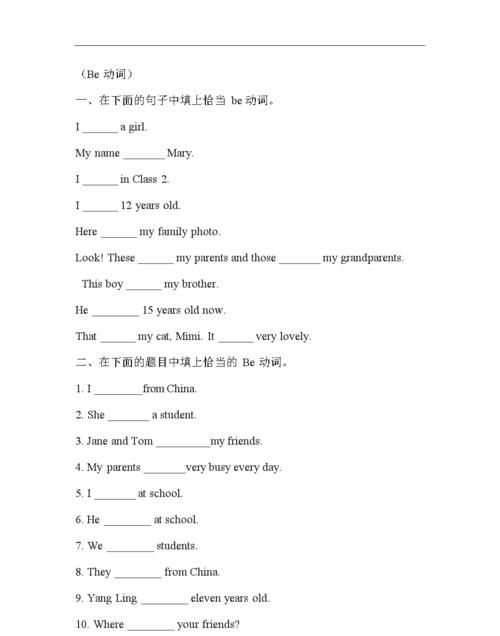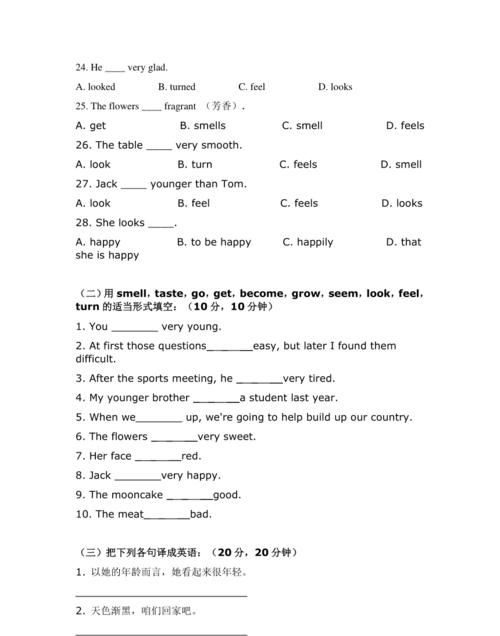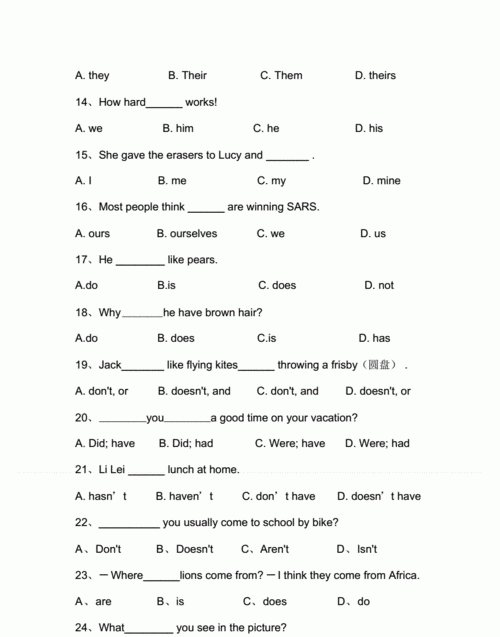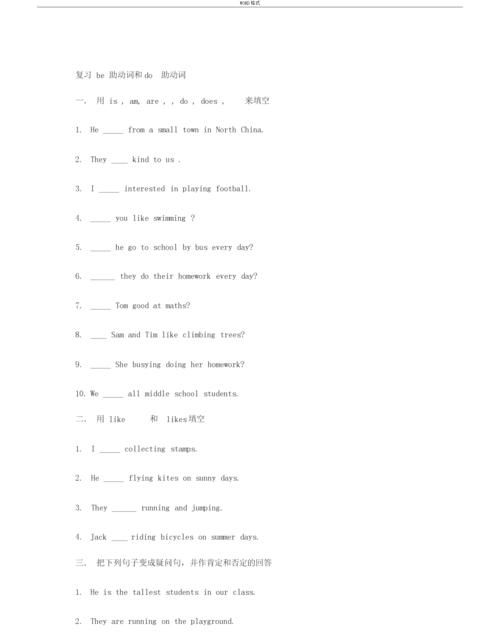本文目录
七年级上册be动词
【模拟试题】 一. 用括号中适当的词填空。 1. I ________(am, are, is) from Australia.
2. She _______ (am, are, is) a student.
3. Jane and Tom _________(am, is, are) my friends.
4. My parents _______ (am, is, are) very busy every day.
5. _______ (Are, Is, Do, Does) there a Chinese school in New York?
6. _______ (Be, Are, Were, Was) they excited when he heard the news?
7. There _____ (be) some glasses on it.
8. If he _____ (be) free tomorrow, he will go with us
. 二. 用所be动词的适当形式填空。
1. A: Where _______the post office. B: It ________ behind the building.
2. A: _______ you miss Black? B: Yes, I ______.
3. It _____ a shirt, it _______(not) a skirt.
4. There ________ a big playground in our school.
5. There ______ many books in my schoolbag.
6. There _________ some fish in the box.
7. _______ there any chairs in the classroom?
8. You’d better _______ early next time.
三. 仿照例句改写下列句子。
例句:She is in Class One, Grade Two. 否定句: She is not in Class One, Grade Two.
一般疑问句: Is she in Class One, Grade Two? 回答:Yes, she is. (No, she isn’t)
1. Bob is on the football team. 否定句: 一般疑问句: 回答:
2. They are in the teacher’s office. 否定句: 一般疑问句: 回答:
3. It is sunny today. 否定句: 一般疑问句: 回答:
4. There is some water in the bottle. 否定句: 一般疑问句: 回答:
5. There is a piano in the room. 否定句: 一般疑问句: 回答:
6. There are many trees in the school. 否定句: 一般疑问句: 回答:
7. There are four bottles of milk on the table. 否定句: 一般疑问句: 回答:
8. We are interested in painting. 否定句: 一般疑问句: 回答:
【试题答案】 一. 答案:1. am 2. is 3. are 4. are 5. Is 6. Were 7. are 8. is 二. 答案:1. is; is 2. Are; am 3. is; isn’t 4. is 5. are 6. is 7. Are 8. be 三. 答案: 1. 否定句:Bob isn’t on the football team. 一般疑问句: Is Bob on the football team? 回答:Yes, he is.( No, he isn’t.) 2. 否定句:They are not in the teacher’s office. 一般疑问句:Are they in the teacher’s office? 回答: Yes, they are. (No, they aren’t.) 3. 否定句: It is not sunny today. 一般疑问句:Is it sunny today? 回答:Yes, it is. (No, it isn’t.) 4. 否定句:There isn’t any water in the bottle. 一般疑问句:Is there any water in the bottle? 回答: Yes, there is. (No, there isn’t.) 5. 否定句: 一般疑问句:Is there a piano in the room? 回答:Yes, there is. (No, there isn’t.) 6. 否定句:There aren’t many trees in the school. 一般疑问句:Are there many trees in the school? 回答:Yes, there are. (No, there aren’t.) 7. 否定句:There are not four bottles of milk on the table. 一般疑问句:Are there four bottles of milk on the table? 回答:Yes, there are. (No, there aren’t) 8. 否定句:We aren’t interested in painting. 一般疑问句:Are you interested in painting?
1、be动词的用法。
be am / is are 现在时
was were 过去时
单数 复数
英语中,be动词选用单数还是复数,要由主语来定,主语是单数,就用单数,反之用复数。
◆ 句中含有be动词时:
肯定句: 主语+be + 其他
否定句: 主语+ be + not + 其他
一般疑问句: Be +主语+其他 +?
特殊疑问句: 疑问词(what / who / when / where) + be +主语 + 其他 +?
I am a teacher. You are right.
She is 16 years old. My father is at home.
The students are playing games. My teacher was ill yesterday.
There is a picture on the wall.
There are two books on the table.
★ be动词用法歌:
我用am,你用are,is 连接他她它。 单数名词用is,复数名词全用are。
变疑问,往前提,句末问号莫丢弃; 变否定,更容易,be后not莫忘记;
疑问否定任你变,句首大写莫迟疑。
★ be动词作谓语,它后面一般跟名词、形容词或介词短语。
2、助动词的用法。
英语句子按正常语序是“什么人或事物” + “做什么”,即,我们常说的“主语 + 谓语 + 其他”。
① 主语为I 或复数名词、代词时:
肯定句: I / We / They / The students + 动词原形 + 其他 + 。
We watch TV every night.
变否定: 主语+ don’t + 动词原形 + 其他 + 。
We don’t watch TV every night.
一般疑问句 Do + 主语 + 动词原形 + 其他 + ?
Do you watch TV every night?
Yes, we do. / No, we don’t.
特殊疑问句:疑问词 + do + 主语 + 动词原形 + 其他 + ?
How often do you watch TV?
② 主语为单数名词或代词时:
肯定句: 主语 + 动词第三人称单数形式 + 其他 + 。
He watches TV every night.
否定句: 主语+ doesn’t+动词原形+其他+。
He doesn’t watch TV every night.
一般疑问句:Does + 主语 + 动词原形 + 其他 + ?
Does he watch TV every night?
Yes, he does. / No, he doesn’t.
特殊疑问句:疑问词 + does + 主语 + 动词原形 + 其他 + ?
How often does he watch TV?
③ 过去时的句式(当句子时态为过去时时, 动词用过去式,不受主语单复数的影响)
肯定句: 主语 + 过去式 + 其他 + 。
He / We got up early every morning last year.
否定句: 主语 + didn’t + 动词原形 + 其他 + 。
He / We didn’t get up early every morning last year.
一般疑问句: Did + 主语 + 动词原形 + 其他 + ?
Did he / you get up early every morning last year?
Yes, he / we did. / No, he / we didn’t.
特殊疑问句: 疑问词 + did + 主语 + 动词原形 + 其他 + ?
When did he / you get up every morning last year?

英语的助动词是什么意思
【答案】
C
【解析】考查时态。主句用一般将来时态,条件状语从句中的信息词
now
表明空格处用一
般现在时态。句意:如果我们现在还不行动起来保护环境
,
我们将会后悔。
20.
【
2013
新课标
II
卷
7
】
We_______ very early so we packed the night before.
A. leave
B. had left
C. were leaving
D. have left
【答案】
C
【解析】考查动词时态。动词
leave
的时行体表示
"
按计划、安排要做的事情
"
。句意:因为
计划很早离开,所以我们头晚就打好了包。
21.
【
2013
安徽
24
】
I’m calling about the apartment you_______ the other day. Could you tell me
more about it?
A. advertised
B. had advertised
C. are advertising
D. will advertise
【答案】
A
【解析】考查时态。题中结构
the other day
表明用一般过去时。句意:我来电咨询有关你广
告的公寓情况,能告诉一些吗?
22.
【
2013
北京
32
】
—
So what is the procedure?
—
All the applicants _______ before a final decision is made by the authority.
A. interview
B. are interviewing
C. are interviewed
D. are being interviewed
【答案】
C
【解析】
考查动词的语态和时态。
句中
applicants
与
interview
之间为被动关系,
用被动语态;
句子描述一般情况,
用一般现在时态的被动语态。
句意:
做最终决定前所有的申请人需面试。
23.
【
2013
山东
24
】
I didn’t think I’d like the movie, but actually it _______ pretty good.
A. has been
B. was
C. had been
D. would be
【答案】
B
【解析】考查动词时态。句意:我认为我不会喜欢这部电影,而实际上这电影相当好。题中
信息
did
n’t
时态为一般过去时态,陈述过去的事实。
24.
【
2013
山东
27
】
—
Oh no! We’re too late. The train _______ .
—
That’s Ok. We’ll catch the next train to London.
A. was leaving
B
. had left
C. has left
D. has been leaving
【答案】
C
【解析】
考查动词时态。
—
太晚了,
火车已离开了。
—
没关系。
我们可赶下一趟火车去伦敦。
句意表明可知火车已经离开,对现在造成影响,用现在完成时态。
25.
【
2013
四川】
3.Hurry up, kids! The school bus _______ for us!
A. waits
B. was waiting
C. waited
D. is waiting
【答案】
D
【解析】考查动词时态。意:快点儿!校车在等我们!现在进行时表示讲话时正发生的事。
句意表明空格处的动作在目前正在发生,用现在时行时

助动词的作用
essere做助动词 1、运动型不及物动词,从某处出发或到达某处。如arrivare, tornare, partire, uscire, entrare, scappare 2.自反动词 3.动词的被动式和不

用助动词的适当形式填空
你好,这道题的正确答案是:
1. __Do_you like this magazine?
2. The girl_doesn't_like bread for breakfast.
3.What _does_ she _do_ at the weekends? ---She usually plays games with her friends.
4.Wha_did_ you do last Sunday? ---I wrote to my friend.
***************************************************
^__^祝你学习进步,如果有疑问,请追问,
如果对你有所帮助,请千万别忘记采纳哟!
***************************************************

以上就是关于含助动词的题 ,七年级上册be动词的全部内容,以及含助动词的题 的相关内容,希望能够帮到您。
